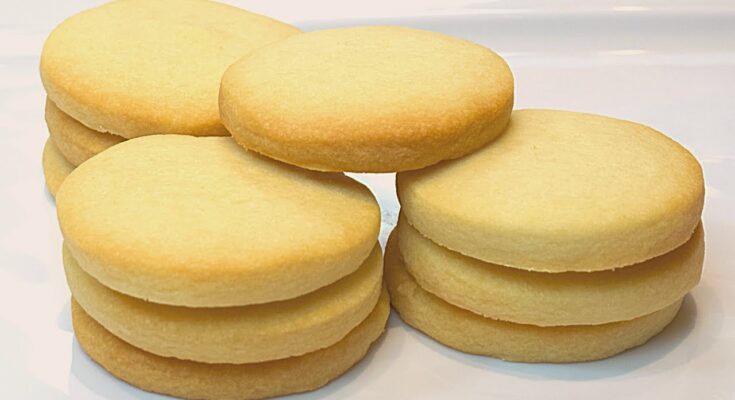Shortbread Recipe: Shortbread is a classic, buttery biscuit that melts in your mouth with every bite. It’s a simple yet indulgent treat that pairs perfectly with tea, coffee, or even as a standalone dessert. Known for its rich, crumbly texture, shortbread is made using just three basic ingredients—flour, sugar, and butter. This recipe is ideal for both beginner and experienced bakers due to its simplicity and minimal preparation time.
History and Origin of Shortbread
Shortbread has roots dating back to 12th-century Scotland, where it was initially a luxurious treat reserved for celebrations. Originally, it evolved from a medieval biscuit bread, which was baked twice to achieve a hard, crisp texture. Over time, butter replaced yeast, transforming it into the delicate, crumbly dessert we know today. Traditionally associated with Christmas and New Year celebrations, shortbread has become a global favorite due to its simplicity and versatility.
Why Shortbread is Popular?
Shortbread is loved for its rich flavor, soft texture, and ease of preparation. It’s an excellent option for gifting during holidays or serving as an elegant dessert at parties. Its long shelf life and adaptability to different flavors make it a versatile cookie that suits every occasion. Whether dipped in chocolate, flavored with vanilla, or infused with citrus zest, shortbread offers endless possibilities to satisfy sweet cravings.
Ingredients and Tools Required
Key Ingredients for Shortbread
To create the perfect shortbread, you’ll need just three main ingredients:
- Butter (1 cup or 226g) – Use unsalted, high-quality butter for a richer flavor.
- Sugar (½ cup or 100g) – Granulated or powdered sugar works well, depending on preference.
- All-Purpose Flour (2 cups or 240g) – Ensures the dough holds its shape while baking.
Optional Ingredients for Flavor Enhancements:
- Vanilla Extract (1 tsp) for a hint of sweetness.
- Salt (¼ tsp) to balance flavors.
- Chocolate Chips or Nuts for added texture.
Essential Tools for Baking Shortbread
- Mixing Bowls – To combine ingredients easily.
- Hand Mixer or Stand Mixer – For smooth dough preparation.
- Measuring Cups and Spoons – To ensure accurate ingredient proportions.
- Baking Sheet – Lined with parchment paper for even baking.
- Rolling Pin – To flatten the dough evenly.
- Cookie Cutter – To create attractive shapes.
- Wire Rack – For cooling the cookies after baking.
Step-by-Step Guide to Make Shortbread
Step 1: Preparing the Ingredients
Begin by gathering all your ingredients and tools. Preheat your oven to 325°F (163°C) to ensure it’s ready by the time your dough is prepared.
- Measure Ingredients Properly: Use precise measurements to avoid altering the dough texture.
- Soften the Butter: Allow the butter to reach room temperature for easier mixing.
- Prepare Baking Tray: Line a baking sheet with parchment paper to prevent sticking.
Pro Tip: Chill the butter for about 10 minutes if it gets too soft while preparing.
Step 2: Mixing the Dough
- Cream the Butter and Sugar: Use a hand mixer or stand mixer to beat the butter and sugar until light and fluffy. This process should take about 3–4 minutes.
- Add Vanilla (Optional): Mix in the vanilla extract or any additional flavoring you prefer.
- Incorporate the Flour: Gradually add the flour, mixing it at low speed until the dough comes together.
Note: Avoid overmixing to maintain the crumbly texture. If the dough seems dry, knead it gently with your hands.
Step 3: Shaping and Cutting the Dough
Once the dough is well combined, it’s time to shape it into cookies.
- Flatten the Dough: Lightly flour your work surface and rolling pin. Roll out the dough to about ¼ inch (6 mm) thickness. This ensures even baking and the classic shortbread texture.
- Cut the Shapes: Use a cookie cutter, knife, or even a drinking glass to cut out shapes. Traditional shortbread is often cut into rectangles, circles, or wedges, but feel free to get creative with festive designs.
- Dock the Cookies: Use a fork to prick small holes into each cookie. This step prevents bubbling and ensures even baking.
Pro Tip: If the dough becomes sticky while rolling, chill it in the refrigerator for 10–15 minutes before continuing.
Step 4: Baking the Shortbread
- Arrange on Baking Sheet: Place the shaped cookies on the prepared baking tray, leaving about 1 inch (2.5 cm) of space between each piece.
- Bake Slowly: Bake the shortbread at 325°F (163°C) for 15–20 minutes or until the edges start to turn a light golden color. Avoid overbaking to preserve the soft texture.
- Check for Doneness: Shortbread should be pale and lightly golden around the edges but not browned on top.
Pro Tip: Rotate the tray halfway through baking for even heat distribution.
Step 5: Cooling and Storing the Cookies
- Cool on a Wire Rack: Once baked, allow the cookies to rest on the baking tray for 5 minutes before transferring them to a wire rack. This helps prevent crumbling.
- Store Properly: Place the completely cooled cookies in an airtight container. They can last for 2–3 weeks at room temperature or up to 3 months when frozen.
Pro Tip: Layer cookies with parchment paper in storage containers to avoid sticking.
Variations and Add-ons
Flavor Variations to Try
Shortbread is a versatile base that pairs well with various flavors. Here are a few ideas to spice up your recipe:
- Chocolate-Dipped Shortbread: Dip half of each cookie in melted chocolate and let it set for a luxurious finish.
- Lemon Zest and Glaze: Add 1 tsp of lemon zest to the dough and drizzle with a lemon glaze for a citrusy kick.
- Almond Shortbread: Mix in ½ cup of finely chopped almonds or almond extract for a nutty flavor.
- Spiced Shortbread: Incorporate ½ tsp cinnamon or nutmeg for a warm, spiced flavor perfect for the holidays.
Decorating Ideas for Shortbread
- Icing Designs: Use royal icing to pipe intricate patterns on the cookies.
- Sprinkles and Sugar Crystals: Sprinkle colorful sugar crystals or edible glitter before baking for added sparkle.
- Drizzle Chocolate or Caramel: Create elegant designs by drizzling melted chocolate or caramel over the cookies.
- Stamped Designs: Use cookie stamps to emboss patterns before baking for a decorative touch.
Tips and Tricks for Perfect Shortbread
Common Mistakes to Avoid
Even though shortbread is simple to make, a few common mistakes can lead to disappointing results. Here’s what you should watch out for:
- Using Cold Butter: Cold butter won’t blend well, leaving chunks in the dough. Always use softened butter at room temperature.
- Overmixing the Dough: Overworking the dough can make the cookies tough instead of crumbly. Mix just until the ingredients are combined.
- Skipping the Chilling Step: If the dough is too soft, it can spread too much during baking. Chill it briefly before rolling if needed.
- Baking at Too High a Temperature: Shortbread requires slow baking at a low temperature to avoid browning. Stick to 325°F (163°C) for the best results.
- Measuring Ingredients Incorrectly: Precision matters with shortbread. Too much flour makes it dry, while too much butter results in spreading. Use a kitchen scale for accuracy.
Pro Tips for Soft and Crumbly Texture
- Use High-Quality Butter: The flavor of shortbread heavily depends on the butter, so opt for a high-quality, unsalted variety.
- Chill the Dough Before Baking: Refrigerating the shaped dough for 15–20 minutes helps retain its shape while baking.
- Dust with Sugar After Baking: For an elegant look, sprinkle powdered sugar over the cookies while they’re still warm.
- Experiment with Add-Ins: Don’t hesitate to add flavors like orange zest, lavender, or espresso powder for a unique twist.
- Slice Evenly: Ensure uniform thickness while cutting the dough to prevent uneven baking.
FAQs about Shortbread Recipe
What are the key ingredients in a shortbread recipe?
Traditional shortbread recipes typically require just three ingredients: butter, sugar, and flour. Some variations might include salt or vanilla extract for added flavor.
How long does it take to make shortbread?
Preparation time for shortbread is minimal, usually about 10 to 15 minutes to mix the ingredients. Baking time can range from 20 to 30 minutes, depending on the thickness of the cookies and the desired crispness.
Can I make shortbread without butter?
Butter is a crucial ingredient in shortbread for both flavor and texture. However, you can substitute it with margarine or vegan butter alternatives if needed, though this may slightly alter the taste and texture.
Is shortbread gluten-free?
Traditional shortbread is not gluten-free as it contains wheat flour. However, you can make gluten-free shortbread by substituting the wheat flour with a gluten-free flour blend designed for baking.
How do I ensure my shortbread is perfectly crumbly?
The key to crumbly shortbread is the right butter-to-flour ratio and not overworking the dough. Mix the ingredients until just combined and press into your baking form gently.
Can I add flavors to my shortbread recipe?
Absolutely! Common additions include lemon zest, chocolate chips, lavender, or nuts. Experimenting with different mix-ins can add a delightful twist to the traditional recipe.
How should I store shortbread?
Shortbread can be stored in an airtight container at room temperature. It typically lasts well for up to 3 weeks, making it perfect for gifting or gradual snacking.
Conclusion
Making shortbread at home is incredibly rewarding. Its buttery, crumbly texture and melt-in-your-mouth flavor make it a favorite treat for all occasions. Whether you stick to the traditional recipe or experiment with flavors and decorations, shortbread offers endless possibilities. With just a few ingredients and simple steps, you can create bakery-style cookies right in your kitchen.
So, the next time you’re in the mood for baking, try this classic shortbread recipe. Share it with friends and family, gift it during holidays, or enjoy it with a warm cup of tea. Once you master the basics, you’ll find yourself making batch after batch of this timeless delight!



